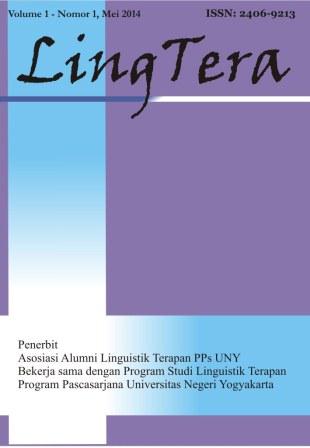The effectiveness of using video and pictures in teaching writing hortatory exposition text
DOI:
https://doi.org/10.21831/lt.v5i2.15490Keywords:
media, teaching writing, hortatory exposition text, genre-based approachAbstract
This study aimed to find out the differences in the students' achievement in writing the hortatory exposition text among the students taught by using video, pictures, and the lecturing method with the genre-based approach. This study was quasi-experimental research with the pretest and the posttest design. The sample consisted of grade eleven students of majoring science comprising three classes chosen by cluster random sampling. Two classes were for the experimental groups taught using video and pictures and the control group taught using the lecturing method. The data were collected using the test of writing. The validity established was the content validity, while the reliability used was inter-rater. Analysis of covariance (ANCOVA) was used to analyze data. The results of the study had shown that there were the significant differences between the experimental and the control groups where the use of video was the most effective media in teaching writing.
References
Anitah, S. (2012). Media pembelajaran. Surakarta: Yuma Pustaka
Arsyad, A. (2011). Media pembelajaran. Jakarta: Raja GrafindoPersada.
Bearne, E., & Wolstencroft, H. (2007). Visual approaches to teaching writing. London: Paul Chapman Publishing.
Dunn, D. S. (2001). Statistics and data analysis for the behavioral sciences. New York: McGraw Hill.
Falupi, S. N., Arifin, Z., & Novita, D. (2013). Teaching descriptive text writing by using video to junior high school students. Jurnal Pendidikan dan Pembelajaran, 2(3). Retrived from http://jurnal.untan.ac.id/index.php/jpdpb/article/view/1363
Feez, S. & Joyce, H. (1998). Text-based syllabus design. Sydney: AMES.
Garrand, T. (2006). Writing for multimedia and the web. Oxford: Elsevier.
Harmer, J. (2001). The practice of English language teaching. Essex, England: Longman.
Harmer, J. (2004). How to teach writing. Essex, England: Longman.
Heinich, R., Molenda, M., Russell, J. D., &Smaldino, S. E. (2002). Instructional media and technologies for learning. New York: Merill Prentice Hall.
Hillocks, G. (2010). Teaching argument for critical thinking and writing: An introduction. English Journal, 99 (6), 24-32
Johnson, A. P. (2008). Teaching reading and writing: A guidebook for tutoring and remediating students. Plymouth: The Rowman& Littlefield Publishing Group, Inc.
Knapp, P., & Watkins, M. (2005). Genre, text, grammar: Technologies for teaching and assessing writing. Sydney: UNSW Press.
McDonough, J., Shaw, C., & Masuhara, H. (2013). Materials and methods in ELT: A teacher's guide.3rd. Oxford: Wiley-Blackwell.
Mills, K., & Dooley, K. (2014). Teaching persuasive texts: Building a language of evaluation through hedging and moderated intensification. Literacy Learning: The Middle Years, 22(3), 33-41.
Nunan, D. (2003). Practical English language teaching. New York: The McGraw Hill Companies.
Rahman, M. M. (2011). Genre-based writing instruction: Implications in ESP classroom. English for Specific Purposes World, 11(33), 1-9.
Raimes, A. (1983). Techniques in teaching writing. Oxford: Oxford University Press.
Ravid, R. (2011). Practical statistics. Plymouth: Rowman& Littlefield Publishers, Inc.
Richards, J. C. (2006). Communicative language teaching today. Cambridge: Cambridge University Press.
Scrivener, J. (2005). Learning teaching: A guidebook for English language teachers. Oxford: Macmillan.
Warschauer, M. (2010). Invited commentary: New tools for teaching writing. Language learning & technology, 14(1), 3-8.
Downloads
Published
How to Cite
Issue
Section
Citation Check
License
LingTera allows readers to read, download, copy, distribute, print, search, or link to its articles' full texts and allows readers to use them for any other lawful purpose. The journal allows the author(s) to hold the copyright without restrictions. Finally, the journal allows the author(s) to retain publishing rights without restrictions.
- Authors are allowed to archive their submitted articles in an open-access repository.
- Authors are allowed to archive the final published article in an open-access repository with an acknowledgment of its initial publication in this journal.

Psychology, Evaluation, and Technology in Educational Research is licensed under a Creative Commons Attribution-ShareAlike 4.0 International License.
Based on a work at https://petier.org/index.php/PETIER.










